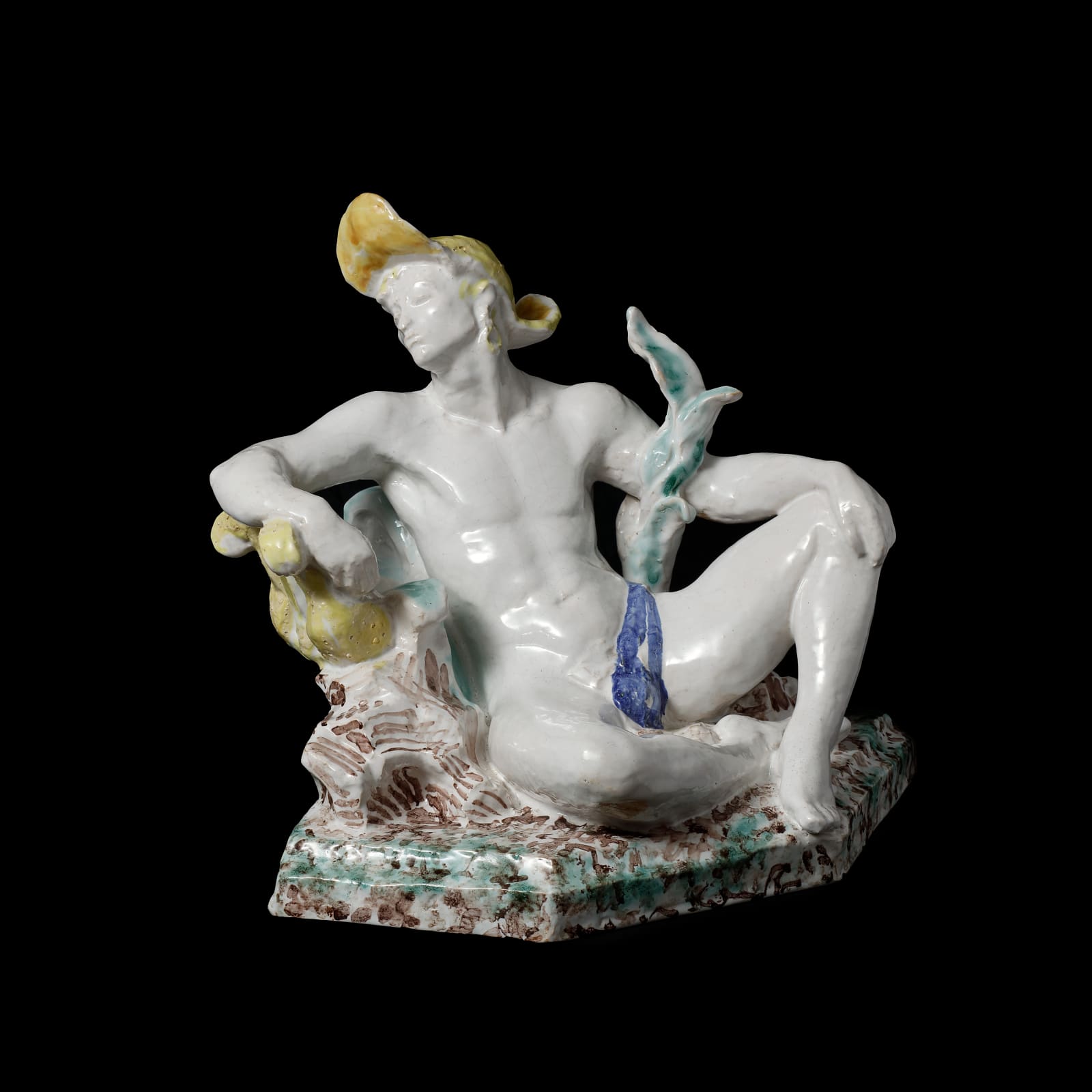


Stephen Tomlin, Phyllis Keyes and Duncan Grant
Further images
Designed by Stephen Tomlin, crafted by Phyllis Keyes and colourfully enriched by Duncan Grant, these captivating figures combine the anatomically congruous qualities of a sculptor, the technical skills of a ceramicist, and the painterly elan of a celebrated painter. Having moved away from sculpture after 1931, the medium of ceramic, particularly in a collaborative form, granted Tomlin a more conducive medium of self-expression.
Although the subjects remain unidentified, the reclining male figure exudes stylish nonchalance, combining the traditional idiom of the ceramic figurine with modernist eroticism. Grant’s loose application of colour and pattern adds further to their engaging presence. Both figures, bedecked in elaborate hats and surrounded by classical symbols, evoke the grandeur of Greeks gods: the male figure rests on a lyre, his lascivious deportment reminiscent of Orpheus, the son of Apollo and legendary Greek musician, prophet and poet. The female figure leans on foliage that reaches over her head in the manner of a conical Thracian Phrygian cap, whilst her right arm rests on what appears to be a stylised representation of a harp. She likely represents one of the Maenads, the followers of Dionysus who were often depicted with Orpheus during the late-nineteenth and early-twentieth centuries; over this period, Orpheus became somewhat of a 'queer icon' on account of his bisexuality and nonconformity.
Although Keyes’s name is perhaps the least recognisable within this illustrious list of artists, a large part of the Bloomsbury group’s artistic legacy would be unrecognisable today without her collaboration. In the years after the demise of the Omega Workshops in 1919, Grant and Bell had minimal engagement with ceramics or pottery until they met Phyllis Keyes in 1931. Keyes took the artists to a kiln where the group experimented with various glazes, from which point an artistic and professional working relationship developed.[1] For several years, Keyes supplied Bell and Grant with ceramics that were either thrown by her or cast from designs on their request (on one occasion Keyes made a copy of a two-handled jug that Grant brought back from his travels). After Keyes produced the models, they were hand-painted by the artists and then finished in her distinctive milky-white tin glaze.[2]
Keyes’ workshop and kiln were on Warren Street, just around the corner from Tomlin’s studio on Percy Street. The pair became friends, and a professional relationship soon ensued. It is possible that these represent one of their earliest collaborations and could be the ceramic works referred to by Lytton Strachey in a concerned letter to Dora Carrington: ‘…I wish something could be done about Tommy—but my imagination fails to cope with it. Would it be out of the question for him to have a short brisk and unimportant love affair of his own for a little. I suppose so! Was anything said about the china figures? One commission there at any rate.’[3] To which Carrington responded: ‘I begged Tommy to get on with the china figures & he said he would.’[4]
Originally, Tomlin helped Keyes design pottery from her Warren Street workshop, but as her popularity grew so did the requirement for a larger workshop. By the time Keyes moved from Warren Street to a larger workshop in nearby Clipstone Street, Tomlin had become her partner, involved in all stages of production. The fruits of Tomlin and Keyes’ collaboration are, unfortunately, now rare. These two reclining nudes appear to be the most ambitious artworks so far recorded. Another pair of figures, without Grant’s painted additions, are held in a private collection but there are no other known figures of this calibre, and none painted so expressively.
[1] F. Spalding, Duncan Grant: A Biography. London: Chatto & Windus, 1997, p.323.
[2] M. Bloch and S. Fox, The Bloomsbury Stud: The Life of Stephen ‘Tommy’ Tomlin. London: M.A.B., 2020.
[3] L. Strachey, Letter to D. Carrington. 20 September 1930. British Library.
[4] D. Carrington, Letter to L. Strachey. September 1930. British Library.
Provenance
The artist;Julia Gowing (formerly Tomlin, née Strachey), the artist’s wife;
by family descent until 2022.
Literature
M. Bloch and S. Fox, The Bloomsbury Stud: The Life of Stephen ‘Tommy’ Tomlin. London: M.A.B., 2023, 2nd edn. p. 248.
O. Garnett, The Sculpture of Stephen Tomlin. Unpublished Thesis, 1979, p. 9, nos. 34a, 35a (illus. figs 133, 134)
Be the first to hear about our available artworks
* denotes required fields
We will process the personal data you have supplied in accordance with our privacy policy (available on request). You can unsubscribe or change your preferences at any time by clicking the link in our emails.


